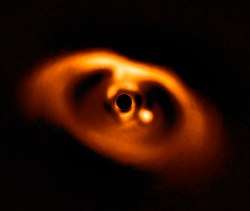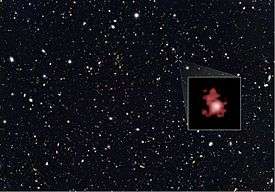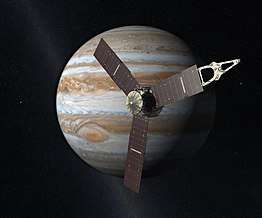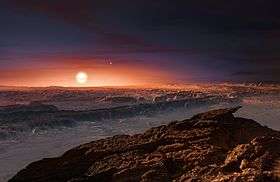BD+20 594b
BD+20594b (also known as K2-56b[1]) is a massive exoplanet discovered by the Kepler spacecraft in collaboration with the HARPS spectrometer at La Silla in Chile.
| Discovery | |
|---|---|
| Discovery site | Kepler Space Observatory, La Silla, |
| Discovery date | 2016 |
| Transit | |
| Orbital characteristics | |
| 0.241 +0.019 −0.017[1] AU | |
| Eccentricity | 0[1] |
| 41.6855 +0.0030 −0.0031[1] d | |
| Inclination | 89.55+0.17 −0.14[1] |
| Star | BD+20°594 |
| Physical characteristics | |
Mean radius | 2.23+0.14 −0.11[1] R⊕ |
| Mass | 16.3 +6.0 −6.1[1] M⊕ |
Mean density | 7.890+3.400 −3.100 g cm−3 |
| Temperature | 546 K (273 °C; 523 °F) +19 −18 K |
Naming
BD+20594b indicates that the planet circles a star found in the Bonner Durchmusterung catalogue, BD +20° 594, the 594th entry in the +20-degree zone (declinations from +19 to +20 degrees); and that it is the first planet discovered orbiting that star.
K2-56b indicates that the planet circles a star catalogued in the Kepler 2 mission catalogue (part of the extended K2 Kepler mission), the 56th one in the catalogue; and that it is the first planet discovered orbiting that star.
Planet
With a radius of 2.2 R⊕ and a mass of 16.31 M⊕, BD+20594b is substantially smaller than Neptune.[2] Taking the estimates of its radius and mass at face value, the composition of the planet would be rocky, hence making it classified as a mega-Earth. BD+20594b's exact composition is still unknown.
The planet was discovered on January 28, 2016 by astrophysicist Néstor Espinoza and his team from the Catholic University of Chile, using data from the two-wheeled Kepler mission (K2). It orbits a K-type star 496.08 light years away in the constellation Taurus.[3]
It is believed that planets with a radius greater than 1.6 times the Earth's are not usually rocky,[4] making BD+20594b an exception to this rule.
See also
References
- "CONFIRMED PLANET OVERVIEW PAGE". NASA Exoplanet Archive. NASA. Retrieved 2016-08-11.
- http://exoplanet.eu/catalog/bd%2B20_594_b/
- Espinoza, Néstor; Brahm, Rafael; Jordán, Andrés; Jenkins, James S; Rojas, Felipe; Jofré, Paula; Mädler, Thomas; Rabus, Markus; Chanamé, Julio; Pantoja, Blake; Soto, Maritza G; Morzinski, Katie M; Males, Jared R; Ward-Duong, Kimberly; Close, Laird M (2016). "Discovery and Validation of a High-Density sub-Neptune from the K2 Mission". The Astrophysical Journal. 830 (1): 43. arXiv:1601.07608. Bibcode:2016ApJ...830...43E. doi:10.3847/0004-637X/830/1/43.
- Rogers, Leslie A; Brahm, Rafael; Jordán, Andrés; Jenkins, James S; Rojas, Felipe; Jofré, Paula; Mädler, Thomas; Rabus, Markus; Chanamé, Julio; Pantoja, Blake; Soto, Maritza G; Morzinski, Katie M; Males, Jared R; Ward-Duong, Kimberly; Close, Laird M (2015). "Most 1.6 Earth-radius Planets are Not Rocky". The Astrophysical Journal. 801 (1): 41. arXiv:1407.4457. Bibcode:2015ApJ...801...41R. doi:10.1088/0004-637X/801/1/41.



